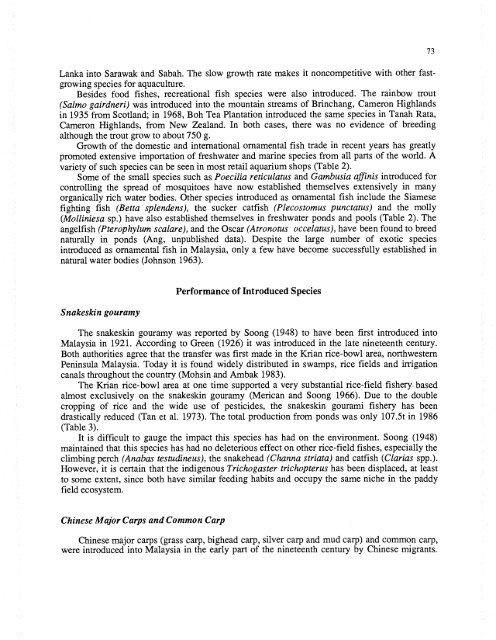Exotic Aquatic Organisms - International Development Research ...
Exotic Aquatic Organisms - International Development Research ...
Exotic Aquatic Organisms - International Development Research ...
Create successful ePaper yourself
Turn your PDF publications into a flip-book with our unique Google optimized e-Paper software.
Lanka into Sarawak and Sabah. The slow growth rate makes it noncompetitive with other fastgrowing<br />
species for aquaculture.<br />
Besides food fishes, recreational fish species were also introduced. The rainbow trout<br />
(Salmo gairdneri) was introduced into the mountain streams of Brinchang, Cameron Highlands<br />
in 1935 from Scotland; in 1968, Boh Tea Plantation introduced the same species in Tanah Rata,<br />
Cameron Highlands, from New Zealand. In both cases, there was no evidence of breeding<br />
although the trout grow to about 750 g.<br />
Growth of the domestic and international ornamental fish trade in recent years has greatly<br />
promoted extensive importation of freshwater and marine species from all parts of the world. A<br />
variety of such species can be seen in most retail aquarium shops (Table 2).<br />
Some of the small species such as Poecilia reticulatus and Gambusia affinis introduced for<br />
controlling the spread of mosquitoes have now established themselves extensively in many<br />
organically rich water bodies. Other species introduced as ornamental fish include the Siamese<br />
fighting fish (Betta splendens), the sucker catfish (Plecostomus punctatus) and the molly<br />
(Molliniesa sp.) have also established themselves in freshwater ponds and pools (Table 2). The<br />
angelfish (Pterophylum scalare), and the Oscar (Atronotus occelatus), have been found to breed<br />
naturally in ponds (Ang, unpublished data). Despite the large number of exotic species<br />
introduced as ornamental fish in Malaysia, only a few have become successfully established in<br />
natural water bodies (Johnson 1963).<br />
Snakeskin gouramy<br />
Performance of Introduced Species<br />
The snakeskin gouramy was reported by Soong (1948) to have been first introduced into<br />
Malaysia in 1921. According to Green (1926) it was introduced in the late nineteenth century.<br />
Both authorities agree that the transfer was first made in the Krian rice-bowl area, northwestern<br />
Peninsula Malaysia. Today it is found widely distributed in swamps, rice fields and irrigation<br />
canals throughout the country (Mohsin and Ambak 1983).<br />
The Krian rice-bowl area at one time supported a very substantial rice-field fishery. based<br />
almost exclusively on the snakeskin gouramy (Merican and Soong 1966). Due to the double<br />
cropping of rice and the wide use of pesticides, the snakeskin gourami fishery has been<br />
drastically reduced (Tan et al. 1973). The total production from ponds was only 107.5t in 1986<br />
(Table 3).<br />
It is difficult to gauge the impact this species has had on the environment. Soong (1948)<br />
maintained that this species has had no deleterious effect on other rice-field fishes, especially the<br />
climbing perch (Anabas testudineus), the snakehead (Channa striata) and catfish (Clarias spp.).<br />
However, it is certain that the indigenous Trichogaster trichopterus has been displaced, at least<br />
to some extent, since both have similar feeding habits and occupy the same niche in the paddy<br />
field ecosystem.<br />
Chinese Major Carps and Common Carp<br />
Chinese major carps (grass carp, bighead carp, silver carp and mud carp) and common carp,<br />
were introduced into Malaysia in the early part of the nineteenth century by Chinese migrants.<br />
73

















